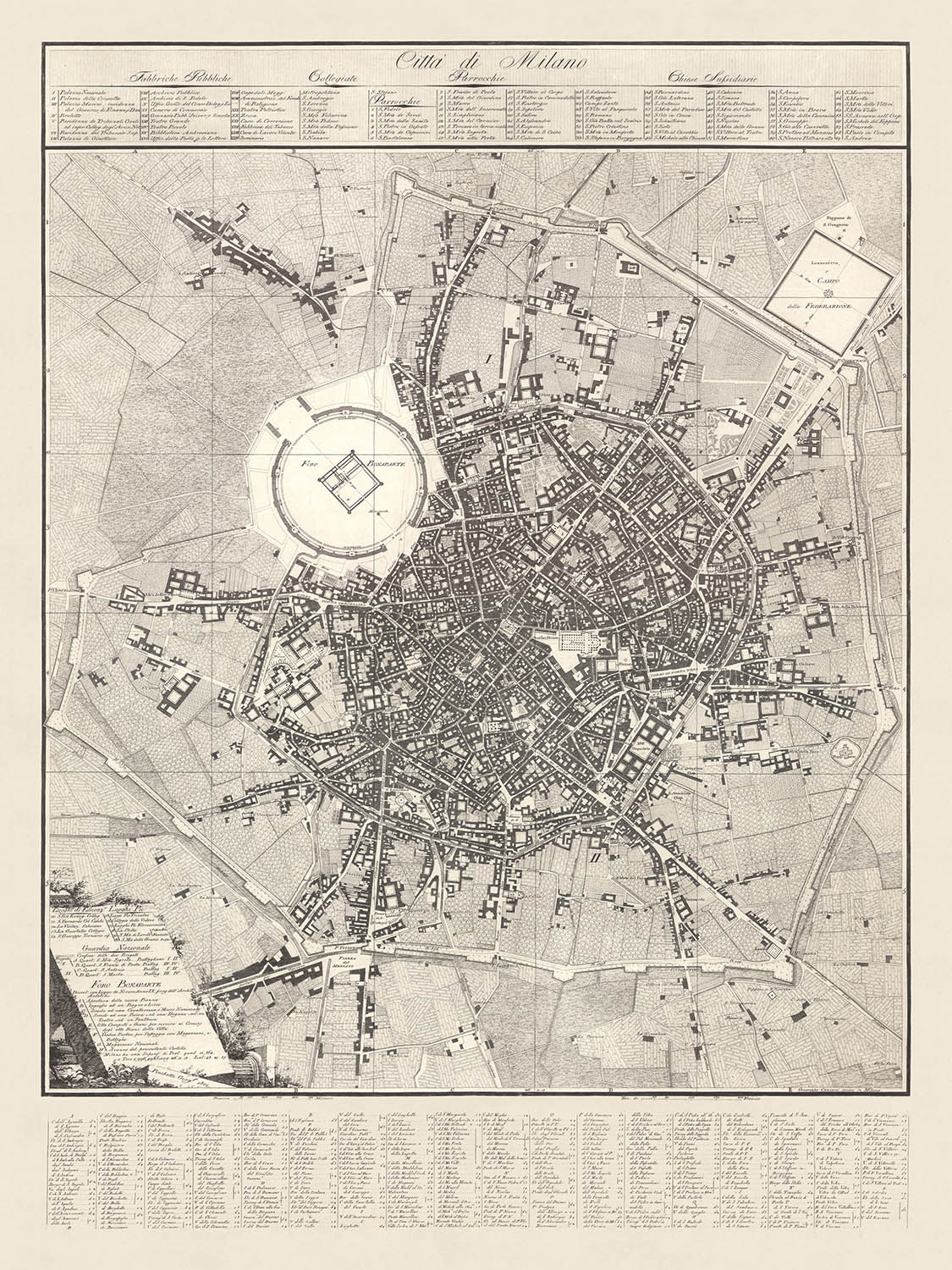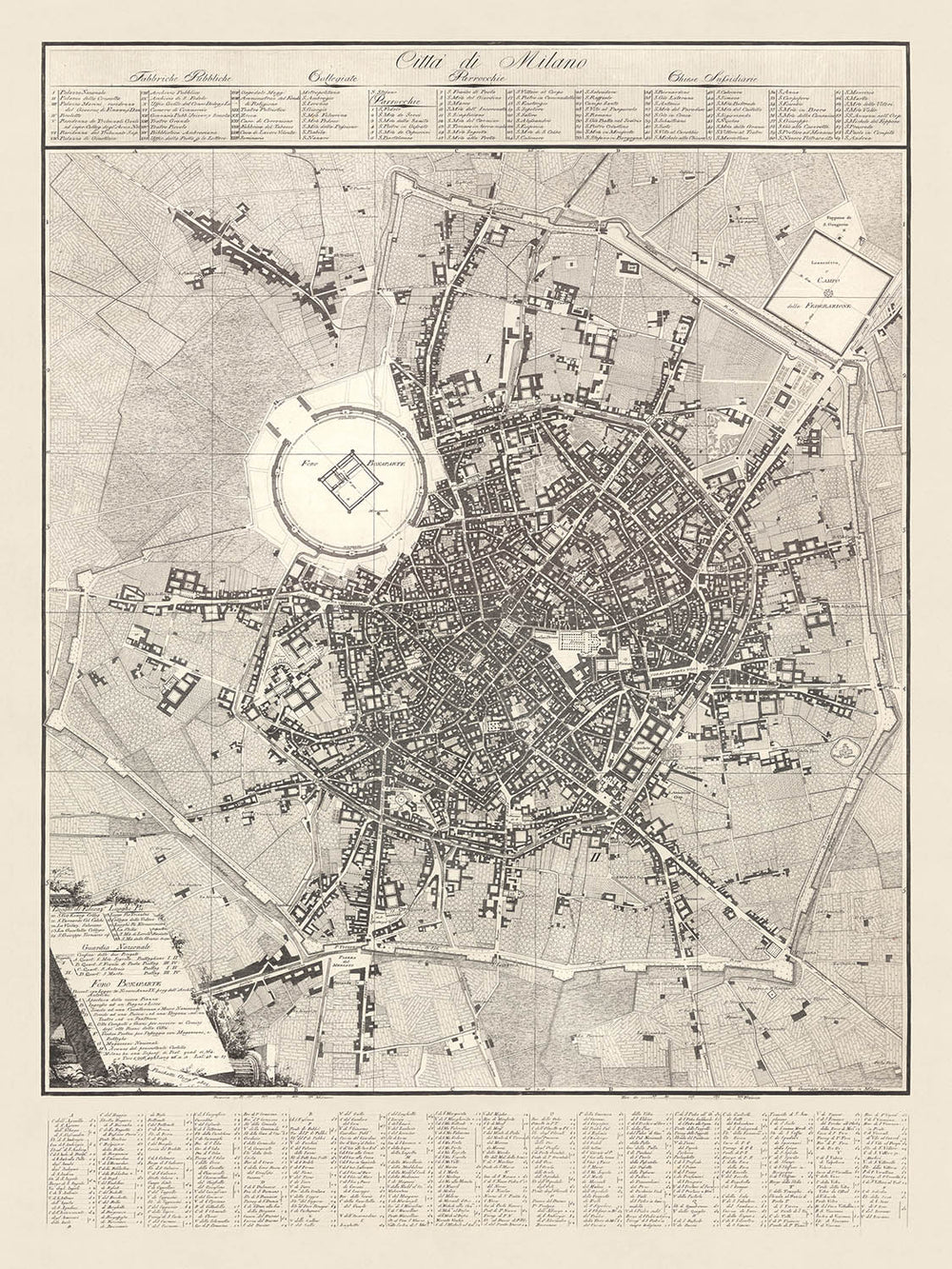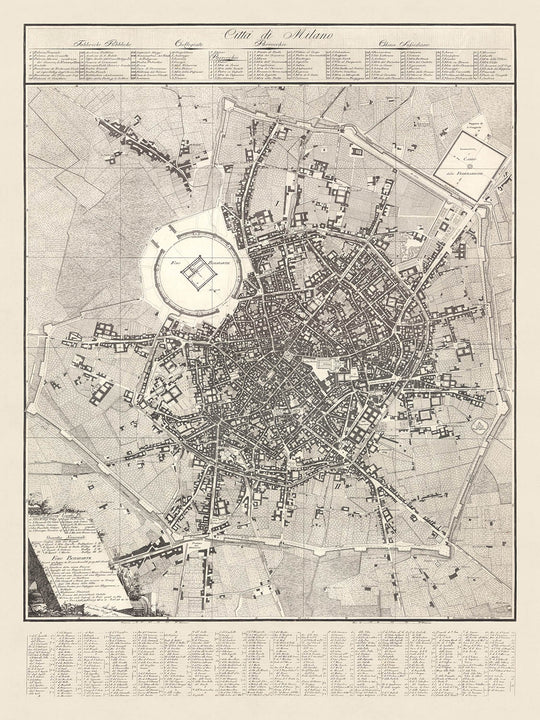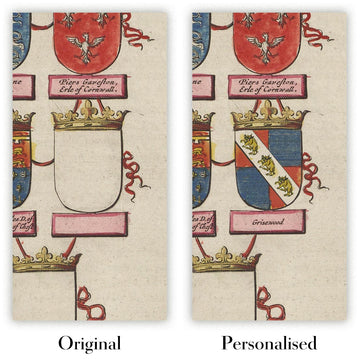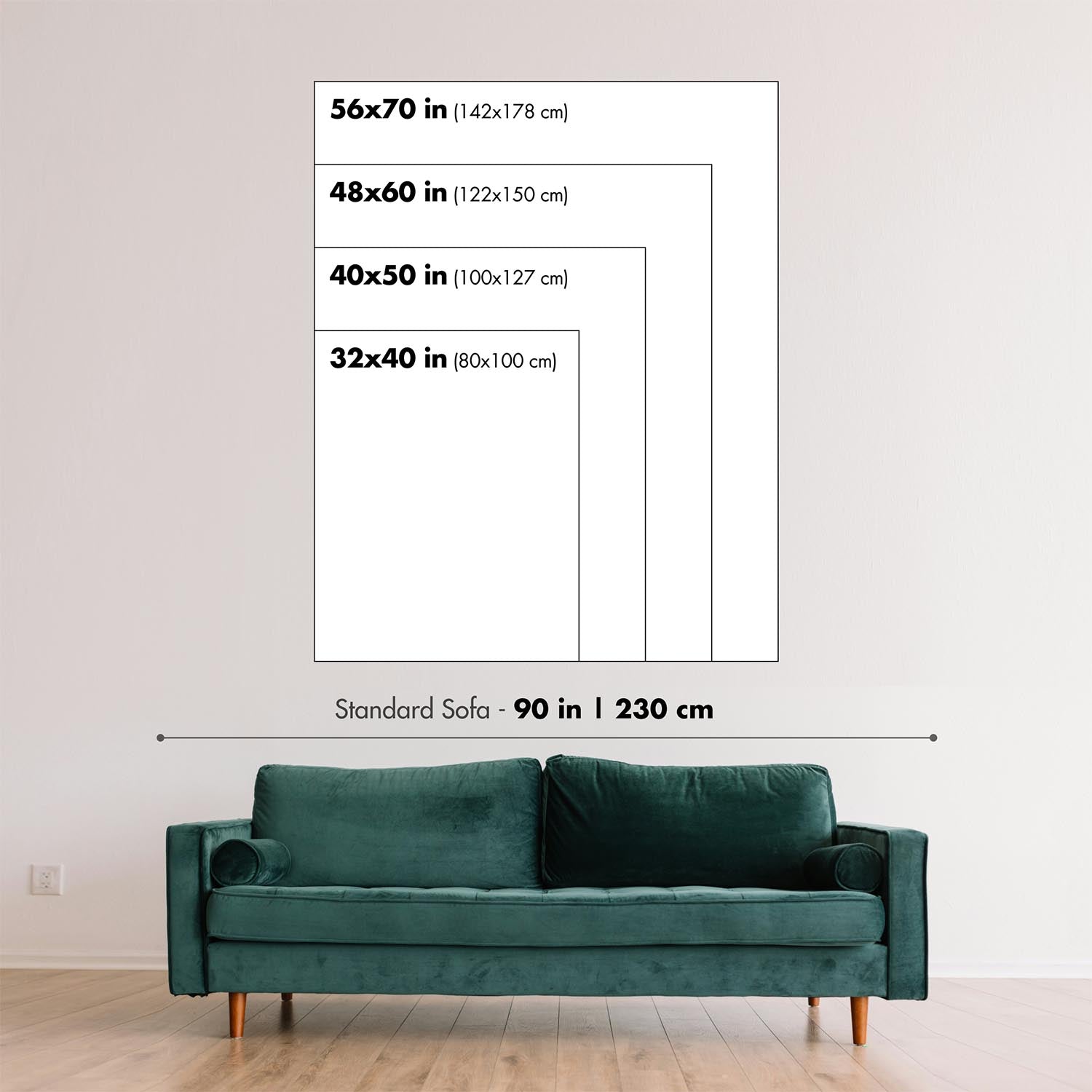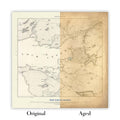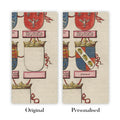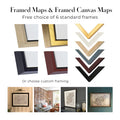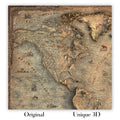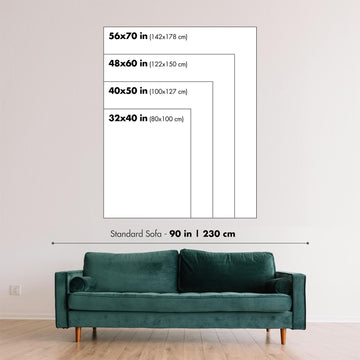- Handmade locally. No import duty or tax
- FREE worldwide delivery
- Love it or your money back (90 days)
- Questions? WhatsApp me any time
Own a piece of history
5,000+ 5 star reviews


La mappa della "Città di Milano", meticolosamente realizzata da Giacomo Pinchetti nel 1801 e incisa da Giuseppe Caniani, è un notevole testamento della grandezza urbana e architettonica della Milano dei primi del XIX secolo. Questa squisita mappa non solo traccia il complesso layout delle strade e delle piazze di Milano, ma incapsula anche la visione ambiziosa dell'era napoleonica, in particolare attraverso il progetto del Foro Bonaparte proposto. Questo progetto, sebbene mai realizzato, prevedeva uno spazio urbano trasformativo con un edificio civile quasi quadrato al suo centro, circondato da edifici pubblici e privati, riflettendo la grandiosità della pianificazione urbana napoleonica.
Uno degli aspetti più affascinanti di questa mappa è la sua dettagliata rappresentazione dei quartieri e dei luoghi significativi di Milano. La Cittadella di Milano, un punto focale del progetto del Foro Bonaparte, è presentata in modo prominente, illustrando la trasformazione prevista di questa fortezza militare in un centro civico. La mappa evidenzia anche il Canale Naviglio, progettato per attraversare la città, migliorando sia il suo appeal estetico che la connettività funzionale. Questo canale era pianificato per uscire dall'area doganale, correre parallelo a un portico continuo e connettersi alla nuova strada per la Francia tramite Sempione, mostrando l'integrazione del design urbano e dei trasporti.
Oltre ai suoi elementi architettonici e infrastrutturali, la mappa fornisce un elenco completo delle fabbriche pubbliche di Milano, delle chiese collegiali, delle parrocchie e delle chiese sussidiarie. Questi sono catalogati meticolosamente in dodici colonne nella parte superiore, offrendo un dettagliato spaccato del paesaggio religioso e industriale della città. L'angolo in basso a sinistra della mappa arricchisce ulteriormente questo arazzo storico dettagliando i luoghi di istruzione, i luoghi pii e la Guardia Nazionale, sottolineando la natura multifaccettata della società milanese dell'epoca.
Il design della mappa è una lezione di eleganza cartografica, con scale grafiche in Braccia Milanesi e Tese di Francia, fornendo misurazioni precise per riferimento contemporaneo e futuro. Le diciotto colonne in fondo, che elencano i nomi delle strade, delle piazze e delle porte, servono come una preziosa directory, guidando l'osservatore attraverso le strade labirintiche di Milano. Questa dettagliata enumerazione non solo aiuta la navigazione, ma offre anche intuizioni sul tessuto urbano e sulla nomenclatura del periodo.
Storicamente, la mappa della "Città di Milano" è significativa per la sua rappresentazione di una visione urbana ambiziosa che, nonostante la sua non realizzazione, riflette le aspirazioni e il dinamismo della Milano napoleonica. Essa rappresenta un documento prezioso per storici, urbanisti e appassionati di cartografia, offrendo una finestra sul passato della città e sui grandi progetti che hanno plasmato il suo sviluppo. Questa mappa non è solo una rappresentazione delle strade e degli edifici di Milano; è una narrazione dei sogni di una città e delle forze storiche che hanno influenzato la sua evoluzione.
Strade e vie in questa mappa
- Corso di Porta Romana
- Corso di Porta Ticinese
- Corso di Porta Venezia
- Corso di Porta Vercellina
- Piazza del Duomo
- Piazza San Babila
- Piazza Santo Stefano
- Piazza dei Mercanti
- Piazza della Scala
- Piazza del Carmine
- Piazza di Santa Maria
- Piazza di Sant'Ambrogio
- Piazza di San Fedele
- Piazza del Castello
- Piazza Beccaria
- Piazza Fontana
- Piazza Cavour
- Piazza Sant'Alessandro
- Piazza San Sepolcro
- Piazza San Nazaro in Brolo
- Piazza San Marco
- Piazza San Simpliciano
- Piazza San Giovanni in Conca
- Piazza San Carlo
- Piazza San Lorenzo
- Piazza San Maurilio
- Piazza Santa Maria alla Porta
- Piazza San Bernardino alle Ossa
- Piazza San Francesco di Paola
- Piazza San Vittore al Corpo
Caratteristiche e monumenti notevoli
- Illustrazioni:
- Incisioni dettagliate di edifici e layout della città.
- Monumenti:
- Foro Bonaparte (area del progetto).
- Citadella di Milano.
- Quartieri:
- Vari distretti della città sono dettagliati.
- Grandi parchi:
- L'area attorno alla Citadella sembra essere pianificata come spazio aperto nel progetto del Foro Bonaparte.
Contesto storico e di design
- Nome della mappa: Città di Milano
- Data di creazione: 1801
- Cartografo/Editore: Giacomo Pinchetti, inciso da Giuseppe Caniani
- Fabbriche pubbliche, Chiese collegiali, Parrocchie e Chiese sussidiarie: Elencate in dodici colonne in alto.
- Nomi di strade, piazze e porte: Inclusi in diciotto colonne in basso.
- Luoghi di istruzione, Luoghi pii, Riferimenti alla Guardia Nazionale e al Foro Bonaparte: Dettagliati nell'angolo in basso a sinistra con riferimenti secondo il progetto Antolini.
- Scale grafiche: Braccia Milanesi e Tese di Francia.
- Progetto del Foro Bonaparte di Antolini: Un significativo progetto dell'era napoleonica proposto per trasformare la Citadella di Milano con vari edifici pubblici e privati, portici e un Naviglio Canal ridisegnato. Nonostante l'inizio simbolico nel 1801, il progetto non è mai stato avviato.
- Pianificazione urbana e architettura: Sottolinea il progetto del Foro Bonaparte.
- Istituzioni religiose e pubbliche: Elenchi dettagliati di chiese e fabbriche pubbliche.
- Istruzione e pietà: Luoghi di istruzione e luoghi pii sono notati.
- Paesi e regioni mostrati: La mappa si concentra sulla città di Milano, Italia.
- Design e stile:
- Layout dettagliato di strade ed edifici.
- Ampio uso di elenchi e colonne per categorizzare le informazioni.
- Elementi cartografici classici con scale in unità locali.
- Importanza storica:
- Fornisce un'idea della pianificazione urbana milanese dei primi anni del 1800.
- Riflette l'influenza napoleonica sullo sviluppo della città.
- Documenta un ambizioso ma non realizzato progetto di trasformazione urbana.
Si prega di controllare attentamente le immagini per assicurarsi che una specifica città o luogo sia mostrato su questa mappa. Puoi anche contattarci e chiedere di controllare la mappa per te.
Questa mappa sembra fantastica in ogni dimensione, ma consiglio sempre di optare per una dimensione più grande se hai spazio. In questo modo puoi facilmente distinguere tutti i dettagli.
Questa mappa appare straordinaria in dimensioni fino a 100in (250cm). Se stai cercando una mappa più grande, per favore contattami.
Si prega di notare: le etichette su questa mappa sono difficili da leggere se ordini una mappa che è 20in (50cm) o più piccola. La mappa è comunque molto attraente, ma se desideri leggere la mappa facilmente, ti preghiamo di acquistare una dimensione più grande.
Il modello nelle immagini dell'inserzione sta tenendo la versione 18x24in (45x60cm) di questa mappa.
La quinta immagine dell'inserzione mostra un esempio del mio servizio di personalizzazione della mappa.
Se stai cercando qualcosa di leggermente diverso, dai un'occhiata alla mia collezione delle migliori vecchie mappe per vedere se qualcosa colpisce la tua attenzione.
Per favore contattami per verificare se una certa posizione, punto di riferimento o caratteristica è mostrata su questa mappa.
Questo sarebbe un meraviglioso regalo per un compleanno, Natale, Festa del Papà, pensionamento, anniversario o inaugurazione della casa per qualcuno delle aree coperte da questa mappa.
Questa mappa è disponibile come stampa giclée su carta opaca archiviata senza acidi, oppure puoi acquistarla incorniciata. La cornice è una bella e semplice cornice nera che si adatta alla maggior parte degli stili. Per favore, contattami se desideri un colore o un materiale della cornice diverso. Le mie cornici sono rivestite con acrilico super chiaro di grado museale (perspex/acrylite), che è significativamente meno riflettente del vetro, più sicuro e arriverà sempre in condizioni perfette.
This map is also available as a float framed canvas, sometimes known as a shadow gap framed canvas or canvas floater. The map is printed on artist's cotton canvas and then stretched over a handmade box frame. We then "float" the canvas inside a wooden frame, which is available in a range of colours (black, dark brown, oak, antique gold and white). This is a wonderful way to present a map without glazing in front. See some examples of float framed canvas maps and explore the differences between my different finishes.
For something truly unique, this map is also available in "Unique 3D", our trademarked process that dramatically transforms the map so that it has a wonderful sense of depth. We combine the original map with detailed topography and elevation data, so that mountains and the terrain really "pop". For more info and examples of 3D maps, check my Unique 3D page.
For most orders, delivery time is about 3 working days. Personalised and customised products take longer, as I have to do the personalisation and send it to you for approval, which usually takes 1 or 2 days.
Please note that very large framed orders usually take longer to make and deliver.
If you need your order to arrive by a certain date, please contact me before you order so that we can find the best way of making sure you get your order in time.
I print and frame maps and artwork in 23 countries around the world. This means your order will be made locally, which cuts down on delivery time and ensures that it won't be damaged during delivery. You'll never pay customs or import duty, and we'll put less CO2 into the air.
All of my maps and art prints are well packaged and sent in a rugged tube if unframed, or surrounded by foam if framed.
I try to send out all orders within 1 or 2 days of receiving your order, though some products (like face masks, mugs and tote bags) can take longer to make.
If you select Express Delivery at checkout your order we will prioritise your order and send it out by 1-day courier (Fedex, DHL, UPS, Parcelforce).
Next Day delivery is also available in some countries (US, UK, Singapore, UAE) but please try to order early in the day so that we can get it sent out on time.
My standard frame is a gallery style black ash hardwood frame. It is simple and quite modern looking. My standard frame is around 20mm (0.8in) wide.
I use super-clear acrylic (perspex/acrylite) for the frame glass. It's lighter and safer than glass - and it looks better, as the reflectivity is lower.
Six standard frame colours are available for free (black, dark brown, dark grey, oak, white and antique gold). Custom framing and mounting/matting is available if you're looking for something else.
Most maps, art and illustrations are also available as a framed canvas. We use matte (not shiny) cotton canvas, stretch it over a sustainably sourced box wood frame, and then 'float' the piece within a wood frame. The end result is quite beautiful, and there's no glazing to get in the way.
All frames are provided "ready to hang", with either a string or brackets on the back. Very large frames will have heavy duty hanging plates and/or a mounting baton. If you have any questions, please get in touch.
See some examples of my framed maps and framed canvas maps.
Alternatively, I can also supply old maps and artwork on canvas, foam board, cotton rag and other materials.
If you want to frame your map or artwork yourself, please read my size guide first.
Alcune delle mie vecchie mappe sono ora disponibili come tele incorniciate. Per favore contattami se desideri ordinare una dimensione che non è disponibile nel mio negozio.
Le vecchie mappe su tela sono un'alternativa interessante alle mappe incorniciate in modo convenzionale. A seconda del tuo gusto personale e dell'arredamento della stanza, le mappe su tela possono "risaltare" un po' di più rispetto a una mappa incorniciata.
My maps are extremely high quality reproductions of original maps.
I source original, rare maps from libraries, auction houses and private collections around the world, restore them at my London workshop, and then use specialist giclée inks and printers to create beautiful maps that look even better than the original.
My maps are printed on acid-free archival matte (not glossy) paper that feels very high quality and almost like card. In technical terms the paper weight/thickness is 10mil/200gsm. It's perfect for framing.
I print with Epson ultrachrome giclée UV fade resistant pigment inks - some of the best inks you can find.
I can also make maps on canvas, cotton rag and other exotic materials.
Learn more about The Unique Maps Co.
Map personalisation
If you're looking for the perfect anniversary or housewarming gift, I can personalise your map to make it truly unique. For example, I can add a short message, or highlight an important location, or add your family's coat of arms.
The options are almost infinite. Please see my map personalisation page for some wonderful examples of what's possible.
To order a personalised map, select "personalise your map" before adding it to your basket.
Get in touch if you're looking for more complex customisations and personalisations.
Map ageing
I have been asked hundreds of times over the years by customers if they could buy a map that looks even older.
Well, now you can, by selecting Aged before you add a map to your basket.
All the product photos you see on this page show the map in its Original form. This is what the map looks like today.
If you select Aged, I will age your map by hand, using a special and unique process developed through years of studying old maps, talking to researchers to understand the chemistry of aging paper, and of course... lots of practice!
If you're unsure, stick to the Original colour of the map. If you want something a bit darker and older looking, go for Aged.
Se non sei soddisfatto del tuo ordine per qualsiasi motivo, contattami per un rimborso senza problemi. Si prega di consultare la nostra politica di reso e rimborso per ulteriori informazioni.
Sono molto sicuro che ti piacerà la tua mappa restaurata o la stampa d'arte. Lo faccio dal 1984. Sono un venditore Etsy a 5 stelle. Ho venduto decine di migliaia di mappe e stampe d'arte e ho oltre 5.000 recensioni reali a 5 stelle.
Utilizzo un processo unico per restaurare mappe e opere d'arte che richiede molto tempo e lavoro. Trovare le mappe e le illustrazioni originali può richiedere mesi. Utilizzo tecnologia all'avanguardia e incredibilmente costosa per scannerizzare e restaurarle. Di conseguenza, garantisco che le mie mappe e stampe d'arte siano superiori alle altre - ecco perché posso offrire un rimborso senza problemi.
Quasi tutte le mie mappe e stampe d'arte sembrano fantastiche a grandi dimensioni (200 cm, 6,5 piedi+) e posso anche incorniciarle e consegnarle a te, tramite un corriere speciale per oggetti di grandi dimensioni. Contattami per discutere delle tue esigenze specifiche.
Or try searching for something!







